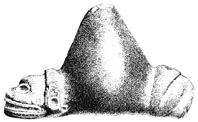

 | Page 269 |  |
indicate the degree of similarity and difference among the groups of local peoples and cultures to which they refer (Rouse 1986, 10–11, 117–120).
The taxonomy of peoples and cultures thus established has been primarily used to trace the origin and development of the Tainos, whom Columbus encountered in the northern part of the West Indies (Map 3). By plotting the distributions of the ethnic groups, subseries, and series on chronological charts, the students of this problem have been able to identify Meillacan and Chican, the latest two subseries within the Ostionoid series, as Taino (Fig. 2). They have traced the ancestry of the Tainos back from these two subseries to a previous Ostionan Ostionoid subseries and thence through a Cedrosan Saladoid subseries—which occupied the Lesser Antilles, the northern half of the Guianas, and the eastern coast of Venezuela around the time of Christ—to a Ronquinan Saladoid subseries, which had previously arisen in the Orinoco Valley (Rouse 1992, 71–137).
Most attention has been paid in recent years to the central part of this trajectory, that is, to the expansion of the Cedrosan Saladoid peoples from the Guianan and east Venezuelan coasts to the Lesser Antilles and Puerto Rico at the entry into the Greater Antilles. We have found that the migrants proceeded selectively, settling first on large, mountainous islands with extensive river systems like those along which they had lived on the mainland. They quickly displaced the previous Ortoiroid inhabitants of the Lesser Antilles and Puerto Rico but came to a halt at a frontier on the eastern top of Hispaniola and remained there for some 500 years before being able to displace the Casimiroid peoples who inhabited the bulk of Hispaniola and all of Cuba. While living on that frontier they evolved into the Ostionoid peoples and cultures who eventually became the Tainos of the historic age.
From time to time, participants in the research on Taino ancestry have proposed other, mutually contradictory migration hypotheses. One archaeologist or another has concluded that each of the Saladoid and Ostionoid subseries was the result of a separate migration from South America into the West Indies. The proponents of the various hypotheses have been unable to agree on them, nor have they been able to agree on the places of origin in South America. These conflicts have arisen because the advocates of the alternative hypotheses have limited themselves to ceramics. To be successful in reconstructing population movements one must take into consideration all aspects of culture for which there is any archaeological documentation. In other words, one must classify whole assemblages, not just the ceramic parts of the assemblages.
Because Caribbeanists have done just that in the case of the Saladoid series, they have been able to reach a consensus that its peoples migrated from the South American mainland. Most also conclude that the Saladoids evolved into the Ostionoids and thence into the Tainos after they reached the Greater Antilles. Studies of the origin and development of settlement patterns, ball and dance courts, subsistence agriculture, tools and ornaments, art, and the three-pointed type of zemi all indicate the validity of this sequence of events. For example, three-pointers are now known to have been brought into the West Indies by the Saladoids and to have been handed down by them through the Ostionoids to the Tainos. The tools became larger and began to be elaborately carved under the influence of Casimiroid art (Fig. 3).

Figure 3. Taino three–pointed Zemi
(after Rouse 1992, Figure 29a)
Physical anthropological and linguistic research has shed further light on the origin of the Tainos. Tacoma (1991) has noted significant differences between the human craniums and long bones from archaic- and ceramic-age burials on the island of Aruba off the coast of Venezuela dating
 |  |